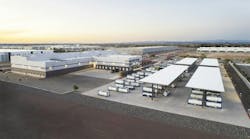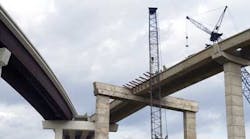The diverse group, whose membership includes former Republican and Democratic Senate and House members, mayors, business and civic leaders, and transportation stakeholders and experts, on December 8, 2010, called for new revenues to provide adequate investment in the nation's transportation infrastructure to advance specific national transportation goals.
The combined groups called for:
-
Targeted investments in the transportation system from all levels of government and the private sector in order to adequately serve the nation's growing population.
-
Users of the transportation system to bear more of the full costs of the infrastructure they demand to address congestion, pollution, and other indirect impacts.
-
Congress to increase federal motor fuel taxes.
“America's roads, bridges and transit systems form the foundation of our economy and our quality of life,” said Kathy J Caldwell, ASCE president. “Now, as many of those critical systems are sliding closer and closer to failure, we are getting hit with the harsh reality that treating the problem with short-term policy solutions and ‘band aid’ funding measures hasn't been successful or beneficial to our long-term outlook.
“Investing in infrastructure will never be cheap, and having that conversation while families and businesses are struggling will be difficult. However, we must remember that the failing infrastructure is already having an impact on the wallet of each and every American, whether it's in wasted fuel, declining productivity, or increasing costs for everything from milk to blue jeans. This isn't a Republican issue or a Democrat issue. It's an American issue, and we have to demand that it be treated as such.
“Because they take the same approach in their own homes, Americans understand that when resources are scarce you must invest wisely and efficiently, and require accountability for those investments. It's time that our political leaders follow suit.
“That is why the American Society of Civil Engineers continues to urge Congress and the White House to take a leadership position on ensuring that the nation's transportation infrastructure is able to meet our needs, both now, and in the future. By overhauling existing policies to provide better performance standards and accountability measures, as well as long-term, stable sources of funding, our leaders can help us maintain and improve America's global competitiveness and quality of life.”
In 1998, ASCE released its first Report Card for America's Infrastructure — an assessment of the nation's critical infrastructure conducted by an advisory panel of the nation's leading civil engineers whose specializations and areas of expertise covered a broad spectrum — and conferred an overall grade of D. Subsequent grades were D+ in 2001, D in 2005, and D in 2009.
As noted in the executive summary of the 2009 report card, “The nation's infrastructure faces some very real problems that threaten our way of life if they are not addressed.” The executive summary also places the estimated five-year investment needed to upgrade the nation's infrastructure to a satisfactory level at $2.2 trillion.
ASCE has developed five key solutions for raising the grades on the nation's deteriorating infrastructure. The proposals:
Increase federal leadership in infrastructure: “America's infrastructure needs bold leadership and a compelling national level vision. During the 20th Century, the federal government led the way in building our nation's greatest infrastructure systems from the New Deal programs to the Interstate Highway System and the Clean Water Act. Since that time, federal leadership has decreased, and the condition of the nation's infrastructure suffered. Currently most infrastructure investment decisions are made without the benefit of a national vision. That strong national vision must originate with strong federal leadership and be shared by all levels of government and the private sector. Without a strong national vision, infrastructure will continue to deteriorate.”
Promote sustainability and resilience: “America's infrastructure must meet the ongoing needs for natural resources, industrial products, energy, food, transportation, shelter, and effective waste management, and at the same time protect and improve environmental quality. Sustainability and resiliency must be an integral part of improving the nation's infrastructure. Today's transportation systems, water treatment systems, and flood control systems must be able to withstand both current and future challenges. Both structural and non-structural methods must be applied to meet challenges. Infrastructure systems must be designed to protect the natural environment and withstand both natural and man-made hazards, using sustainable practices, to ensure that future generations can use and enjoy what we build today, as we have benefitted from past generations. Additionally, research and development should be funded at the federal level to develop new, more efficient methods and materials for building and maintaining the nation's infrastructure. Sustainable development will not only preserve the high quality of life and environment we enjoy today, but improve conditions in the future.”
Develop federal, regional, and state infrastructure plans: “Infrastructure investment at all levels must be prioritized and executed according to well conceived plans that both complement the national vision and focus on system wide outputs. Goals of the plan should center on freight and passenger mobility, intermodality, water use, environmental stewardship and encouraging resiliency and sustainability. The plans must reflect a better defined set of federal, state, local, and private sector roles and responsibilities and instill better discipline for setting priorities and focusing funding to solve the most pressing problems. The plans also should complement our broad national goals of economic growth and leadership, resource conservation, energy independence, and environmental stewardship. Infrastructure plans should be synchronized with regional land use planning and related regulation and incentives to promote non-structural as well as structural solutions to mitigate the growing demand for increased infrastructure capacity.”
Address life-cycle costs and ongoing maintenance: “As infrastructure is built or rehabilitated, life-cycle cost analysis should be performed for all infrastructure systems to account for initial construction, operation, maintenance, environmental, safety, and other costs reasonably anticipated during the life of the project, such as recovery after disruption from natural or manmade hazards. Additionally, owners of the infrastructure should be required to perform ongoing evaluations and maintenance to keep the system functioning at a safe and satisfactory level. Life-cycle cost analysis, ongoing maintenance, and planned renewal will result in more sustainable and resilient infrastructure systems and ensure they can meet the needs of future users.”












